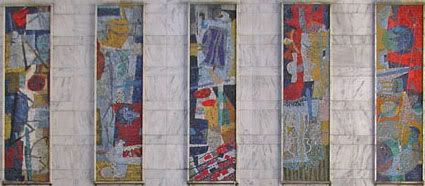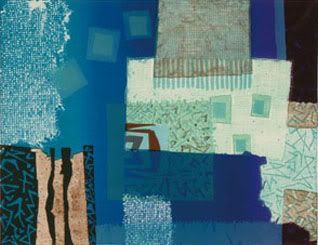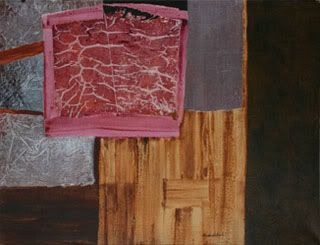 |
five-panel mosaic "Communication"by Roland York Wilson.
The panel was constructed in 1965
[Photo by KPA]
 |
[Photo by KPA]
I recently posted on the Art Deco Concourse building in downtown Toronto, and found that the mosaic in the archway was by Group of Seven artist J.E.H. MacDonald. Across the street from this building is a more recent highrise, with a five-panel mosaic mural on the wall above the entrance. I asked several people about the panels, but the only answer (help) I could get was to look for the information on the Bell Canada site, since the building is the Bell office in Toronto.
Above are photographs of the Bell Canada building with the mosaic panels, and a close-up of the panels. I couldn't find more information on the panels other than that they're collectively called "Communication." The works are clearly of an abstract nature, so what part of their imagery relates to "communication" remains a mystery to me. They appear to be some kind of collage mosaics. Some even look like colored paper that has been ripped or torn, and pasted together to form the image. But they certainly add color to the building and the street.
The building is far less interesting than the Concourse building just across the street, although the marble facade and the railings at the very top might make it more attractive once the construction ramps are removed. The architects are Marani, Morris Allen, who built several other important, but nondescript, buildings around Toronto. The Bell Canada building was completed in 1965.
Around the corner from the building is the new Trump International Hotel and Tower, the reason I went in that neighborhood in the first place. The hotel (which is really a combination of condominiums and hotel rooms) is now complete. It is the usual, glass-heavy, post-modern architecture that is sprouting all over major cities these days, but has none of the beauty and, I think, lasting power, of the older skyscrapers like the Concourse building. The Bell Canada building looks like it was the bridge between the "old" skyscraper age and our new one. Glass and marble are not cheap and they are hard to carve and decorate. So many current buildings are left plain. And it is as thought the expense of the material is enough to throw out ornament.
The artist who designed the panels is Ronald York Wilson (1907-1984) about whom Lawren Harris, another Group of Seven artist, writes:
"Although it is certainly not my customary habit to write so-called fan letters to my colleagues, in this singular instance I feel moved to do so. I made a point of stopping over in Toronto with the express purpose of seeing your imperial oil Murals. I am happily convinced that this break in my journey was completely justified and rewarded, for the murals proved to be beyond my furthest expectations. You have succeeded in a gigantic undertaking, the very thought of which would undoubtedly terrify the great majority of your contemporaries in your own profession..."Here's a brief biographical information on Wilson:
(Lawren Harris to York Wilson, 1959)[Source]
Ronald York Wilson, painter (b at Toronto, Ont 6 Dec 1907; d there 10 Feb 1984). Wilson studied commercial art at Central Technical School and first worked at Brigden's engraving house in Toronto (1926), where he was influenced by Charles COMFORT and Will OGILVIE. Wilson was first recognized for paintings of the burlesque, such as those he exhibited with the Canadian Group of Painters at the World's Fair in New York (1939), and other social commentary pictures. He became a full-time painter in 1950. Trips to Mexico in 1950 and 1953 exposed him to the influence of Rico Lebrun and stimulated an interest in mural painting.And here is more extensive information, including his early influences and decision to take up mural art.
Wilson was best known for his commissioned murals, including those for McGill University's library (Montréal, 1954) and the Imperial Oil Building (Toronto, 1957). In the later 1950s his interest in "picture construction" led him to abstract painting and then, in the 1960s, into geometric art.
Wilson's work reminds me of early 20th century collage art. Although none of his biographers describe his work as collage, some of his painting clearly have that influence. For example, the piece "Blue Opus" which I've posted below is described as "Ink, Lithography, Paper, Print" by one source, and as "Colour mixed media print" by another.
 |
1978, colour mixed media print, 14" x 18.5"
Below is an example of a collage-like painting:
 |
1980, oil on board, 12" × 16"
 |
Acrylic on Canvas, 24" x 32"
And Wilson did create mixed media or collage work.
 |
1943-45, Collage, 15" x 11 1/2"
 |
The Lincoln Center also has panels of murals, by Chagall, in its foyer. Perhaps that is where the Sony Centre got its idea from. On another note, Sony Centre, with its clear reference to a corporate sponsor, has such an empty ring to it compared to the Lincoln Center (which despite this article's ambiguous information, clearly is named after the president).